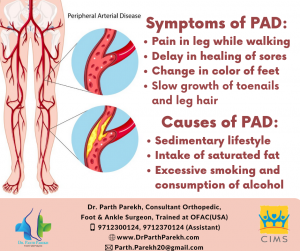Does walking causes leg pain to you? There may be some serious underlying problem.

Often leg pain while walking is considered a sign of ageing and hence they are often ignored. But there may be a serious sign of a cardiac disease called Periphery Artery Disease (usually referred to as PAD). It is caused because of fatty deposits in your arteries to your leg, which limits the supply of blood to muscles in your legs and hence you start feeling pain even with a few minutes of walking. Earlier PAD used to be considered as a men’s only disease. However, newer researches with a broader sample of participants, have found that women are at equal risk. Studies suggest that one in every ten people above 50 years of age suffers from PAD. These numbers are astonishingly high if you look at the older participants. 5 in every 10 people were found to be suffering from PAD, among participants who were 60 years and above.

Symptoms: The pain caused by PAD is different from the soreness you experience due to workout or exercise. The leg pain caused by PAD usually erupts when you walk for some time and goes away as you sit. However, the muscle soreness because of a workout last for hours or days. In some cases of PAD, you also experience cramps in your legs. You start to experience pain in your knees and hips with even slight walking, as the condition gets worse. And if it’s not treated in time you may experience cramps even while sitting too.
Causes: PAD is a cardiovascular disease, which occurs because of fatty deposition in arteries, which carries blood from the heart to the lower part of your body. The accumulation of fat disrupts the flow of blood to the lower part of the body and hence muscle starts hurting. As accumulation in arteries increases, it may block the flow of blood to other organs, including the brain, which may also lead to serious casualties in the patient.
Diagnosis: Usually PAD is accompanied with severe leg pain and cramps even with some movement. However, in some cases, there may not be any pain at all. In that case, you may look for other signs of PAD like change in colour of your feet, slow growth of leg hair and toenails, and delay in healing of sores. If you feel you might be suffering from PAD, you must reach out to foot and ankle specialist for diagnosis. A foot specialist would use a simple procedure called Ankle-Brachial index when the blood pressure in your ankle and arms are compared. If the pressure in the ankle is considerably lower then it indicates PAD in your legs. To further verify, the doctor would conduct angiogram to locate the site of blockage using X Rays or MRI.
Treatment: If the PAD is in its initial stage, the fatty accumulation may be removed through medication, exercise, and healthy living. The doctor would advise to eat more plant proteins and good fat and avoid smoking and consumption of alcohol. You may find it difficult to perform the exercise. However, you must continue exercising even after experiencing pain. If the disease is detected in its advanced stage, the doctor may advise you to undergo angioplasty.
Risk factors: The risk factors of PAD include sedimentary lifestyle, smoking and consumption of alcohol. Also, having a history of diseases like heart attacks, strokes, blood pressure or high blood pressure put you at higher risk of PAD. In some cases, PAD may also be genetic and may be running across generation in your family.
Dr. Parth Parekh
DNB(Orthopaedic) ; D (Orthopaedic) ; M.N.A.M.S (Orthopaedic)
Consultant Orthopaedic Foot And Ankle Surgeon
CIMS Hospital
Science City Road,
Sola,
Ahmedabad, Gujarat India 380060
+91 9712300124
www.drparthparekh.com
www.cims.org
